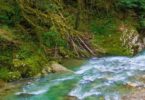Questions about Whales:
What is the largest species of whale?
(a) Blue whale
(b) Humpback whale
(c) Orca (killer whale)
(d) Sperm whale
What is the scientific name of the Humpback whale?
(a) Megaptera novaeangliae
(b) Orcinus orca
(c) Balaenoptera musculus
(d) Physeter macrocephalus
Which of the following statements is true about Blue whales?
(a) They are the smallest species of whales.
(b) They have a hump on their back, hence the name “Blue whale.”
(c) They are known for their intricate songs and vocalizations.
(d) They are not migratory and stay in one area throughout the year.
What is the predominant color of adult Beluga whales?
(a) Gray
(b) Black
(c) White
(d) Blue
What is the scientific name for killer whales?
(a) Delphinus delphis
(b) Orcinus orca
(c) Megaptera novaeangliae
(d) Balaenoptera musculus
What is the approximate length of a fully grown male sperm whale?
(a) 20-30 feet
(b) 40-50 feet
(c) 60-70 feet
(d) 80-90 feet
Which part of a whale’s skull houses the brain?
(a) Sphenoid bone
(b) Mandible
(c) Frontal bone
(d) Occipital bone
Which of the following is true about the bones in a whale’s flipper?
(a) They are rigid and immobile.
(b) They contain joints and flexibility.
(c) They are vestigial and non-functional.
(d) They are hollow and filled with air for buoyancy.
Which whale hunting method involves chasing and harpooning whales from small boats?
(a) Factory ship hunting
(b) Subsistence hunting
(c) Whaling by indigenous communities
(d) Whaling by hand-held harpoons
Which layer of the whale’s body does blubber primarily cover?
(a) Muscles
(b) Bones
(c) Internal organs
(d) Skin
Which whale species is known for its acrobatic behavior and spectacular breaching displays?
(a) Sperm whale
(b) Gray whale
(c) Humpback whale
(d) Minke whale
How long do baby whales typically stay with their mothers?
(a) A few days
(b) A few weeks
(c) Several months
(d) Several years
What is a unique feeding behavior exhibited by Gray whales?
(a) Bubble net feeding
(b) Filter-feeding using baleen plates
(c) Hunting and chasing schools of fish
(d) Grazing on underwater vegetation
What is the term used to describe whale teeth?
(a) Incisors
(b) Canines
(c) Baleen
(d) Ivory
Which part of the whale’s skeleton is often used to estimate its age?
(a) Skull
(b) Ribs
(c) Vertebrae
(d) Flipper bones
Which ocean is the primary habitat for Minke whales?
(a) Atlantic Ocean
(b) Indian Ocean
(c) Pacific Ocean
(d) Southern Ocean
What is the average length of an adult Blue whale?
(a) Around 15 meters
(b) Around 25 meters
(c) Around 35 meters
(d) Around 45 meters
Which adaptation allows whales to stay submerged for extended periods of time?
(a) Blowhole
(b) Dorsal fin
(c) Fluke
(d) Benthic feeding
Which species of whale is known for its elaborate songs and complex vocalizations?
(a) Gray whale
(b) Beluga whale
(c) Humpback whale
(d) Minke whale
What is the primary diet of Blue whales?
(a) Fish
(b) Krill
(c) Squid
(d) Plankton
Related: Cat Trivia Questions
How do killer whales communicate with each other?
(a) Vocalizations and clicks
(b) Body language and gestures
(c) Color changes on their skin
(d) Electric signals
Where do Gray whales undertake one of the longest mammalian migrations?
(a) Atlantic Ocean
(b) Indian Ocean
(c) Pacific Ocean
(d) Southern Ocean
How do baby whales nurse?
(a) They drink milk from their mother’s teats.
(b) They consume small fish and krill.
(c) They filter-feed on plankton.
(d) They are not able to feed on their own.
Which of the following is a migration pattern observed in some whale species?
(a) Moving between Arctic and Antarctic regions
(b) Settling in a specific location year-round
(c) Seasonal movement along the coastline
(d) Random dispersal across the open ocean
Related: Branches Of Science Quiz Questions And Answers
When did the International Whaling Commission (IWC) implement a global ban on commercial whaling?
(a) 1958
(b) 1972
(c) 1986
(d) 1994
What is the color of whale poop?
(a) Green
(b) Blue
(c) Brown
(d) Black
What is the average length of a newborn blue whale?
(a) 3-5 feet
(b) 10-15 feet
(c) 25-30 feet
(d) 50-60 feet
How do whales primarily obtain their food?
(a) Filter-feeding on small marine organisms
(b) Hunting and consuming other marine mammals
(c) Grazing on underwater vegetation
(d) Feeding on plankton and krill
What is the distinctive physical feature of Beluga whales?
(a) Long tusks
(b) Dorsal fin
(c) Fluke
(d) Blowhole
Related: Interesting Bird Trivia Questions (and Answers)
Which of the following is true about whale skeletons?
(a) They have a lightweight skeletal structure made of cartilage.
(b) They have a solid bony skeleton similar to land mammals.
(c) Their skeletons are composed of a mix of cartilage and bone.
(d) They lack a skeletal system altogether.
What is the primary purpose of whale sounds?
(a) Navigation and communication with other whales
(b) Echo-location for detecting food sources
(c) Mating displays and courtship rituals
(d) Defense against predators
Which of the following whales is known for producing complex songs?
(a) Humpback whale
(b) Sperm whale
(c) Blue whale
(d) Beluga whale
Which whale species is the largest animal ever known to have existed?
(a) Sperm whale
(b) Blue whale
(c) Humpback whale
(d) Gray whale
What is the primary function of whale blubber?
(a) Providing insulation and buoyancy
(b) Aiding in digestion of food
(c) Acting as a sensory organ
(d) Assisting in breathing underwater
Blubber of whale is composed of
(a) Skeletal tissue
(b) Muscular tissue
(c) Areolar tissue
(d) Adipose tissue
Why is whale poop important to the marine ecosystem?
(a) It serves as a source of food for smaller organisms.
(b) It provides shelter for marine organisms.
(c) It releases oxygen into the water.
(d) It helps in maintaining water temperature.
Which whale species is generally smaller in size compared to others?
(a) Humpback whale
(b) Sperm whale
(c) Gray whale
(d) Minke whale
What is the average lifespan of a whale?
(a) 10-20 years
(b) 30-50 years
(c) 60-80 years
(d) 90-100 years
What is one distinctive behavior commonly observed in Humpback whales?
(a) Breaching
(b) Spy-hopping
(c) Lobtailing
(d) All of the above
Where are Beluga whales primarily found?
(a) Arctic and subarctic regions
(b) Tropical oceans
(c) Antarctic waters
(d) Coastal areas of North America
What is the average length of an adult Minke whale?
(a) Around 5 meters
(b) Around 10 meters
(c) Around 15 meters
(d) Around 20 meters
What is the primary diet of killer whales?
(a) Fish
(b) Krill
(c) Squid
(d) Marine mammals
What is the purpose of the whale’s baleen plates?
(a) They are used for sound production and communication.
(b) They provide buoyancy and help with swimming.
(c) They serve as a feeding apparatus to filter food from water.
(d) They aid in thermoregulation and heat exchange.
How do whales produce sounds?
(a) By clicking their teeth together
(b) By vibrating their vocal cords
(c) By slapping their tails on the water’s surface
(d) By blowing air through their blowholes
What is a baby whale called?
(a) Calf
(b) Pup
(c) Fawn
(d) Cub
What type of environment do whales typically inhabit?
(a) Freshwater lakes
(b) Coastal estuaries
(c) Deep ocean waters
(d) Shallow coral reefs
Which factor is crucial for the survival of whales in their environment?
(a) Availability of sunlight
(b) Abundance of prey
(c) Temperature fluctuations
(d) Presence of underwater caves
How do scientists estimate the age of a whale by examining its skull?
(a) By counting the number of teeth
(b) By analyzing growth rings in ear bones
(c) By measuring the size of the nasal cavity
(d) By studying the development of eye sockets
How do whales breathe?
(a) Through gills
(b) Through lungs
(c) Through spiracles
(d) Through blowholes
How does whale blubber help in keeping whales warm in cold waters?
(a) It stores large amounts of body fat.
(b) It has a network of blood vessels for temperature regulation.
(c) It produces heat through metabolic processes.
(d) It provides a thick layer of insulation.
What is the purpose of the baleen plates in some whale species?
(a) They aid in swimming and maneuverability.
(b) They provide structure and support to the whale’s body.
(c) They filter and capture small prey, such as krill and fish.
(d) They store large amounts of fat for energy storage.
What is the consistency of whale poop?
(a) Liquid
(b) Gelatinous
(c) Solid
(d) Vaporous
What is a unique feature of a whale’s skull that sets it apart from other mammals?
(a) Lack of teeth
(b) Presence of nasal bones
(c) Absence of eye sockets
(d) Elongated rostrum or snout






